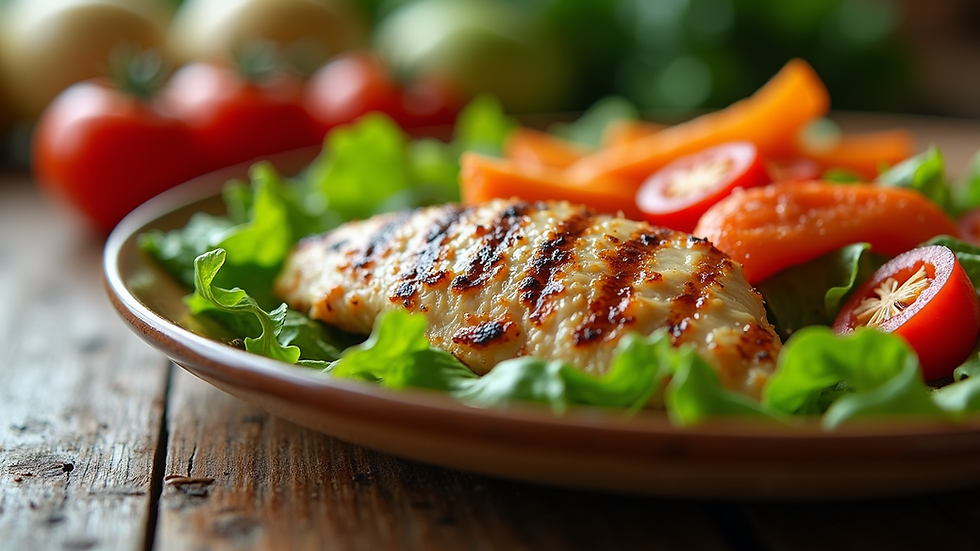Elevate Your Keto Cooking with Chef Tips
- Julie-Ann Booth

- Nov 3
- 4 min read
Keto cooking can sometimes feel limiting, especially when you want to enjoy meals that are both flavorful and satisfying. Many people struggle to keep their keto dishes exciting without falling into repetitive patterns. The good news is that with a few chef-inspired tips, you can transform your keto kitchen into a place of creativity and deliciousness. This post will guide you through practical ways to elevate your keto cooking, making your meals more enjoyable and easier to prepare.

Eye-level view of a colorful keto meal with fresh vegetables and grilled chicken
Understand the Basics of Keto Ingredients
Before diving into advanced cooking techniques, it’s essential to master the foundation: keto-friendly ingredients. Keto diets focus on low carbohydrates, moderate protein, and high fat. Knowing which ingredients fit this profile helps you build meals that keep you in ketosis without sacrificing taste.
Healthy fats: Use olive oil, avocado oil, coconut oil, and butter. These fats add richness and help you feel full.
Low-carb vegetables: Spinach, kale, zucchini, cauliflower, and broccoli are excellent choices. They add texture and nutrients without excess carbs.
Proteins: Choose fatty cuts of meat like ribeye, chicken thighs, and salmon. Eggs are also a versatile protein source.
Nuts and seeds: Almonds, walnuts, chia seeds, and flaxseeds provide crunch and healthy fats.
Dairy: Full-fat cheese, cream, and Greek yogurt can enhance flavor and texture.
By focusing on these ingredients, you create a solid base for your keto meals.
Use Herbs and Spices to Boost Flavor
One common complaint about keto meals is that they can taste bland. Chefs know that herbs and spices are the secret to making dishes pop without adding carbs.
Fresh herbs: Basil, cilantro, parsley, and rosemary add brightness and freshness.
Spices: Cumin, paprika, turmeric, and chili powder bring warmth and depth.
Aromatics: Garlic, ginger, and onions (used sparingly) can enhance flavor layers.
Try experimenting with different combinations. For example, a sprinkle of smoked paprika on roasted cauliflower adds a smoky kick, while fresh basil on a creamy avocado salad brightens the dish.
Master Cooking Techniques That Enhance Keto Meals
How you cook your ingredients can change the entire eating experience. Here are some chef-approved techniques that work well for keto cooking:
Roasting: Roasting vegetables like Brussels sprouts or asparagus caramelizes their natural sugars, creating a rich, sweet flavor without added carbs.
Searing: Quickly searing meats locks in juices and creates a flavorful crust.
Slow cooking: Using a slow cooker or braising tougher cuts of meat makes them tender and flavorful.
Blending: Smooth keto soups or sauces with an immersion blender add creaminess without flour or starch.
For example, roasting cauliflower with olive oil and garlic until golden creates a satisfying side dish that feels indulgent but stays keto-friendly.
Incorporate Fat Wisely for Texture and Satiety
Fat is the cornerstone of keto, but not all fats are equal in cooking. Chefs balance fats to improve texture and keep meals satisfying.
Use butter or ghee for sautéing to add a rich, nutty flavor.
Add avocado or olive oil to salads for smoothness and healthy fats.
Mix cream or full-fat cheese into sauces and soups for creaminess.
Adding fat strategically can turn a simple salad into a filling meal or make a soup feel luxurious.
Plan Your Meals with Variety in Mind
Repetition can make keto feel dull. Planning meals with variety keeps your palate interested and ensures you get a range of nutrients.
Rotate proteins: Try beef one day, fish the next, then chicken or pork.
Change cooking methods: Grill, roast, sauté, or slow cook to vary textures.
Mix vegetables: Combine leafy greens with crunchy options like radishes or celery.
Experiment with international flavors: Use Italian herbs one day, then Mexican spices the next.
For example, a grilled salmon with lemon-dill sauce followed by a slow-cooked beef stew with rosemary keeps your meals exciting.
Use Keto-Friendly Substitutes to Enjoy Favorite Dishes
Missing carb-heavy favorites is common on keto. Chefs often use substitutes to recreate these dishes without breaking keto rules.
Cauliflower rice replaces traditional rice.
Zucchini noodles stand in for pasta.
Almond or coconut flour can be used for baking.
Shirataki noodles offer a low-carb pasta alternative.
Try making keto-friendly pizza with an almond flour crust topped with mozzarella, pepperoni, and fresh basil. This approach lets you enjoy comfort foods while staying on track.
Keep Your Kitchen Stocked with Essentials
Having the right tools and ingredients on hand makes keto cooking easier and faster.
Essential kitchen tools: Sharp knives, a good cutting board, a cast-iron skillet, and a blender.
Staple ingredients: Olive oil, coconut oil, almond flour, canned coconut milk, and a variety of spices.
Fresh produce: Keep a supply of low-carb vegetables and fresh herbs.
When you have these essentials ready, you can whip up keto meals without last-minute trips to the store.
Tips for Eating Out or Meal Prepping on Keto
Eating out or prepping meals ahead can be challenging on keto, but chefs have strategies to help.
When eating out, choose dishes with grilled meats and vegetables. Ask for sauces on the side and avoid bread or starchy sides.
For meal prepping, cook large batches of proteins and vegetables. Store in airtight containers and mix and match during the week.
Use mason jars for salads layered with dressing at the bottom to keep ingredients fresh.
These tips help maintain your keto lifestyle even with a busy schedule.
Elevating your keto cooking doesn’t require complicated recipes or expensive ingredients. By understanding keto basics, using herbs and spices, mastering cooking techniques, and planning for variety, you can enjoy meals that are both healthy and delicious. Start experimenting with these chef tips today and watch your keto kitchen come alive with flavor and creativity.


Comments